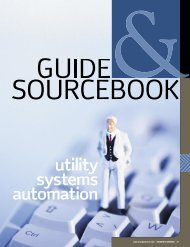Intelligent Utility Jan-Feb 2013
Intelligent Utility Jan-Feb 2013
Intelligent Utility Jan-Feb 2013
Create successful ePaper yourself
Turn your PDF publications into a flip-book with our unique Google optimized e-Paper software.
eported out or is predicted out, it’s<br />
in the list,” Rhoades said. “So it comes<br />
back, and the meters start coming off<br />
the list, and if a meter does not report<br />
back in, the system automatically<br />
pings the meter and determines if the<br />
outage is cleared or not. If the outage<br />
is not cleared, naturally operations<br />
would roll somebody there. We can<br />
do it all in a matter of 10 minutes<br />
versus waiting until somebody makes<br />
a phone call. It has improved our<br />
outage management system and<br />
restoration times. It was one of the<br />
first things we did.”<br />
Rhoades said that, to make it all<br />
work, a utility has to have its interfaces<br />
right, and it has to<br />
monitor those interfaces.<br />
At Southern “<br />
Company, everything<br />
runs on a bus system,<br />
so it is essential to<br />
make sure the bus systems<br />
are operational,<br />
“Because once you<br />
start depending on all<br />
these outages coming<br />
in from your meters,<br />
you need to make sure that systems<br />
are up and operational. It’s taken us a<br />
while to get all the right monitoring<br />
points to make sure they’re flowing<br />
properly,” Rhoades said, “But we got<br />
all that done.”<br />
Alabama Power had some problems<br />
with the ping response time from its<br />
OMS system that reduced the success<br />
rate below an acceptable level, but<br />
setting the priority messages correctly<br />
fixed the problem. “Everything works<br />
fairly well, and it’s a good project,” he<br />
said. “It really helps our distribution<br />
people in managing outages.”<br />
ONCOR Theft detection<br />
and outages<br />
Oncor has 175,000 smart meters<br />
left to install to reach its goal of<br />
3.2 million installed. Jonathan<br />
Pettit, advanced meter system<br />
(AMS) manager at Oncor Electric<br />
Delivery, said the key at Oncor is AMS for a variety of reasons, including analytics<br />
and automation.<br />
“Currently, we have about 250,000 automated operations a day for which, in<br />
the past, we would have had to roll a truck. To date, the automation has saved<br />
between 4 million and 4.5 million truck rolls, along with the associated fuel<br />
and man hours.”<br />
Analytics also help Oncor protect its revenue from loss through theft. The<br />
protection involves the use of manual queries. Pettit said that although the queries<br />
are automated, Oncor doesn’t kick out service orders automatically. He said<br />
the utility wants to reach the point of 90 to 95 percent assurance of true theft or<br />
revenue protection. “The processes have an average 80 percent hit rate in a range<br />
from 60 to 90 percent,” Pettit said. “The one that’s 90 percent is about ready to be<br />
automated. There are many ways to steal electricity, and it’s amazing what people<br />
will do. You’ll find that theft is probably twice as high as you ever thought it was,<br />
and people are twice as smart as you thought they were, too.”<br />
According to Pettit, there is an urban myth that meters give false indications<br />
of outages. “They actually are telling you there’s something wrong with your<br />
secondary,” he said. “Even our meter vendor hadn’t<br />
thought about this. But in 100 percent of the cases<br />
where we had a false indication, we had a loose<br />
terminal or a problem with the transformer. With<br />
predictive analytics, you can learn that there’s<br />
something wrong out there. So we have a team that<br />
does nothing but go around fixing these potential<br />
problems before they occur.”<br />
Pettit described the integration of various systems,<br />
including OMS and DMS, as a “big find,”<br />
but something the utility should roll out in bits<br />
and pieces. However, Oncor’s distribution operation<br />
center said, “This is great!” and all of a sudden, Oncor turned on all of the<br />
integration. “They’ve been happy,” he said. “And now it’s as though they can’t<br />
live without it.”<br />
Pettit said that utilities will likely find that most OMS systems are not ready<br />
to deal with a high quantity of messages. Oncor had an outage that affected a<br />
half-million people. He said the systems are not scaled for millions of outage<br />
messages. “You have to find a way to filter, modify or otherwise limit the amount<br />
of messages,” he said.<br />
Automation has saved<br />
between 4 million and<br />
4.5 million truck rolls,<br />
along with the associ-<br />
ated fuel and man hours.”<br />
The future of analytics<br />
Regardless of the project or challenges, utilities have their eyes open for the next<br />
killer app in analytics.<br />
Rhoades said as Alabama Power integrates its AMI and SCADA data, it would<br />
like to improve light feeders. “Why is one feeder two percent more inefficient<br />
than the next feeder when it should be just like it with the same miles of line?”<br />
he asked. “That’s something in the future we’re looking at.”<br />
Pettit said much of the future for data analytics in Oncor’s projects is unknown.<br />
He said although the smart grid and smart meter programs have been<br />
going on for a long time, they represent the biggest change in the electric utility<br />
industry in 100 years.<br />
H. Christine Richards is the director of knowledge services for the <strong>Utility</strong> Analytics Institute.<br />
You may reach her at crichards@energycentral.com<br />
WWW.INTELLIGENTUTILITY.COM 33


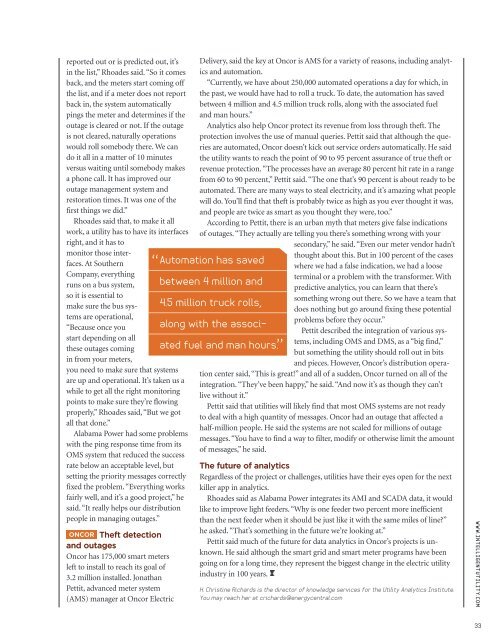
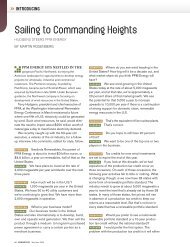

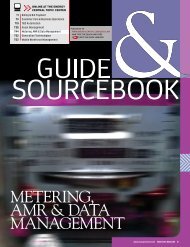

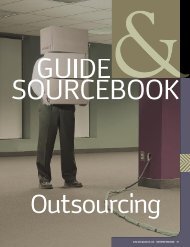







![View From the Trenches [PDF]](https://img.yumpu.com/18854438/1/190x252/view-from-the-trenches-pdf.jpg?quality=85)
